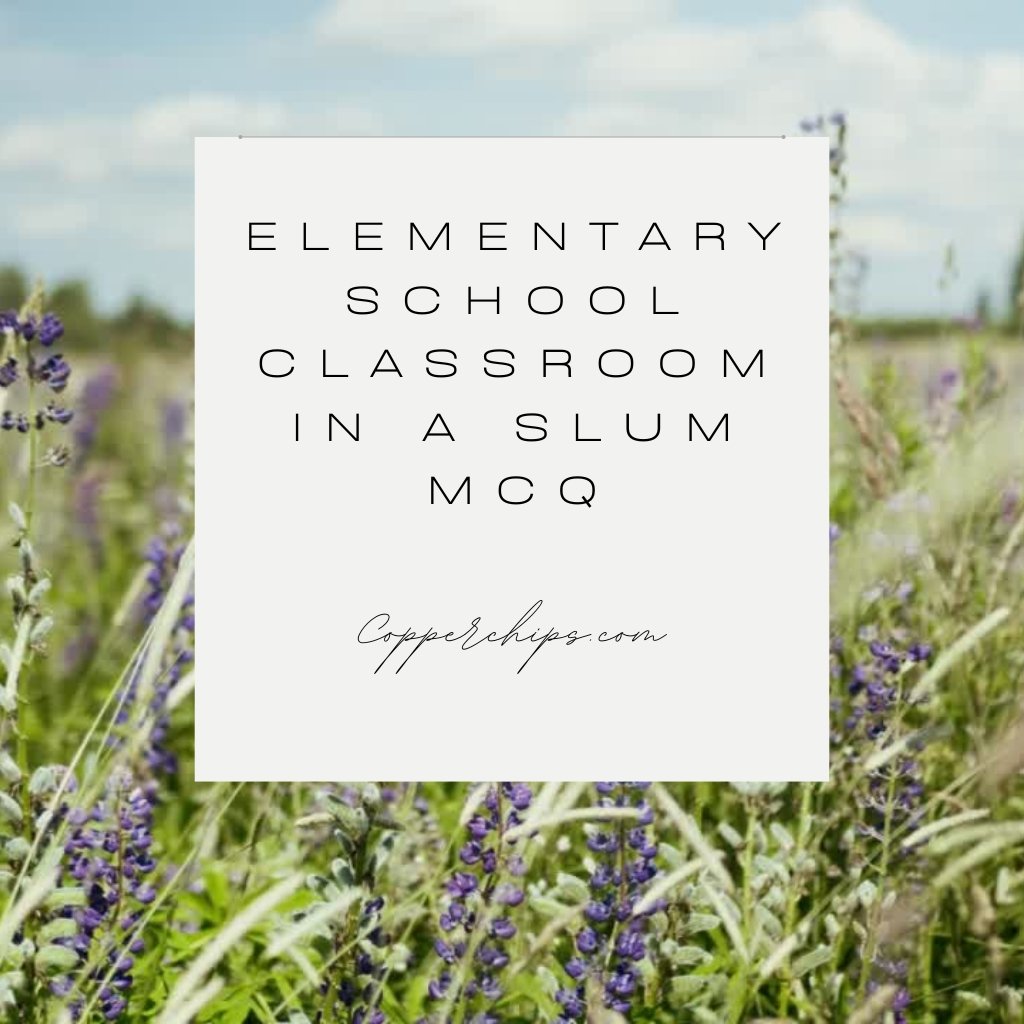Stephen Spender’s An Elementary School Classroom in a Slum MCQ is a compelling poem from the Class 12 English Flamingo book that sheds light on the stark contrasts in society. The poet paints a grim picture of slum children who live in utter neglect, attending a school that lacks basic resources, hope, and purpose. The poem is deeply rooted in themes of social inequality, the hypocrisy of education systems, and the despair of poverty. Through vivid imagery and a melancholic tone, Spender not only captures the emotional and physical suffering of the children but also raises sharp questions about societal apathy.
Elementary School Classroom in a Slum MCQ
Multiple-choice questions (MCQs) in this poem are often found in Class 12 board exams and competitive tests. These questions test not only factual knowledge but also literary interpretation, grammar, tone, poetic devices, and the underlying meaning of the poem. They play a crucial role in exam preparation and help students develop analytical thinking. The MCQs are designed to assess how well one understands the poem’s theme, its vocabulary, symbolism, and the poet’s intent.
Author of the Poem
Stephen Spender, a British poet and essayist, was known for his concern with social justice. He wrote An Elementary School Classroom in a Slum MCQ to highlight the plight of underprivileged children stuck in a system that preaches equality but practices discrimination. Influenced by modernist and realist traditions, Spender combines stark realism with poetic imagery to deliver a socially charged message that demands attention and change.
Themes Explored in the Poem
The poem covers various intense and important themes:
Social Inequality: The children are trapped in poverty, ignored by a society that prefers to turn away.
Hopelessness: There’s a strong sense of despair in their lives, and dreams seem distant.
Educational Disparity: Though they attend school, the education they receive is irrelevant to their lived realities.
False Promises: The maps and pictures in the classroom suggest a world they’ll never access.
Call for Change: The poem ends with a hopeful yet urgent plea to break open the barriers.
Summary of the Poem
The poem is structured in four stanzas, each delivering a distinct message.
Stanza One describes the bleak condition of the children—their physical appearances are distorted by hunger, disease, and neglect.
Stanza Two contrasts the dull classroom with images of a vibrant world depicted on posters, unreachable for these students.
Stanza Three criticizes authorities and society for showcasing these unattainable images, calling them a “bad example.”
Stanza Four urges the government to act, to break down the walls of the classroom, and to give children real education and opportunities.
Line-by-Line Explanation
The poem is rich with metaphors and symbolic language:
“Like rootless weeds”: implies children without identity or support.
“Paper-seeming boy”: suggests weakness and fragility.
“Shakespeare is wicked”: symbolizes irrelevant teachings.
“Break O break open”: a powerful cry for liberation and change.
Understanding these lines helps decode many MCQs with deeper insight.
Important MCQs with Answers
What is the tone of the poem?
a) Joyful
b) Sarcastic
c) Sad and angry
d) Cheerful
Answer: c) Sad and angry
What does the map on the wall signify?
a) Freedom
b) A better world they can’t reach
c) Geography class
d) Hope
Answer: b) A better world they can’t reach
MCQs from the First Stanza
Focus on the setting, imagery, and condition of children.
What do “rootless weeds” signify?
Answer: Children without support or foundation.
What kind of imagery is used to describe the children?
Answer: Negative, visual, and emotional.
MCQs from Second Stanza
Focus on contrasts and irrelevant education.
What is the irony of the posters on the wall?
Answer: They show a life the children can never live.
Why is Shakespeare called “wicked”?
Answer: Because his words mean nothing to starving children.
MCQs from the Third Stanza
Symbolism and poetic criticism.
What is meant by “their future is painted with fog”?
Answer: Their future is unclear and bleak.
Why does the poet call the map a “bad example”?
Answer: It shows things far removed from the children’s reality.
MCQs from Final Stanza
Hope and the poet’s demand for reform.
What does “break O break open” refer to?
Answer: Breaking barriers to provide real education.
What is the poet’s vision for the children?
Answer: To enjoy freedom, nature, and true learning.
Grammar and Vocabulary in the Poem
The poet uses:
Harsh diction to depict suffering (“slag heap,” “rootless weeds”).
Metaphors for the children’s condition.
Contrasting adjectives to create a difference between what is and what should be.
Educational Challenges Highlighted
The poem shows how slum children are:
Deprived of basic needs.
Denied access to quality education.
Trapped in a cycle of poverty and neglect.
Figurative Language in the Poem
Alliteration: “sealed in with a lead sky”
Personification: “Shakespeare is wicked”
Enjambment: Ideas continue without punctuation to intensify the tone.
Tone and Mood of the Poem
Tone: Angry, critical, compassionate.
Mood: Sombre, reflective, inspiring in the end.
Visual Imagery in the Poem
Strong visual cues:
Pale faces
Twisted bones
Fog-filled future
Contrast with “clear sky” and “gold sands”
Symbolism in the Poem
Map: Unrealistic aspirations.
Sky and Sea: Freedom and opportunity.
Windows: Barriers that need to be shattered.
Poetic Devices and their MCQs
Questions often test:
Metaphor
Simile
Irony
Enjambment
Symbolism
Contextual MCQs for CBSE and Other Boards
Expect MCQs like:
“What does the classroom represent?”
“What does the fog imply?”
How to Solve Poetry-Based MCQs
Tips:
Read the poem thoroughly.
Understand literal and symbolic meanings.
Eliminate wrong options smartly.
Watch out for traps.
Common Mistakes in Poetry MCQs
Ignoring poetic devices.
Failing to grasp tone.
Misinterpreting metaphorical language.
MCQs for Class 12 English Flamingo
This poem is included in Flamingo, and questions may cover:
Tone
Setting
Literary devices
Meaningful lines
Model Test Paper MCQs
Includes 10–15 MCQs with answer keys.
Helps in time-bound practice.
Reflects actual board format.
MCQs Based on Literary Devices
Common devices:
Alliteration: “future painted with fog”
Contrast: rich vs poor
Symbolism: map, sky
Teacher’s Tips to Master the Poem
Use visual aids to understand imagery.
Memorize symbolic meanings.
Practice MCQs regularly.
Learning Outcomes After Reading
A better understanding of poetry.
Critical thinking development.
Social awareness about poverty and education.
MCQs Based on Poetic Tone
Sadness and anger dominate.
Ends with hope and vision for change.
Character Sketch MCQs
Children are described as weak, sick, and helpless.
Poet’s Intent MCQs
To highlight social injustice.
To demand systemic reform in education.
Application-Based MCQs
Understanding the importance of real education.
Connecting poem themes to modern challenges.
Conclusion and Takeaway
An Elementary School Classroom in a Slum is not just a poem—it’s a mirror to society. It exposes the hypocrisy of educational systems that promise opportunity but deliver very little to the underprivileged. The MCQs related to this poem help reinforce literary analysis and critical thought. When studying it, focus not just on facts but also on feelings. Because behind every line lies a voice—often unheard—pleading for change.








